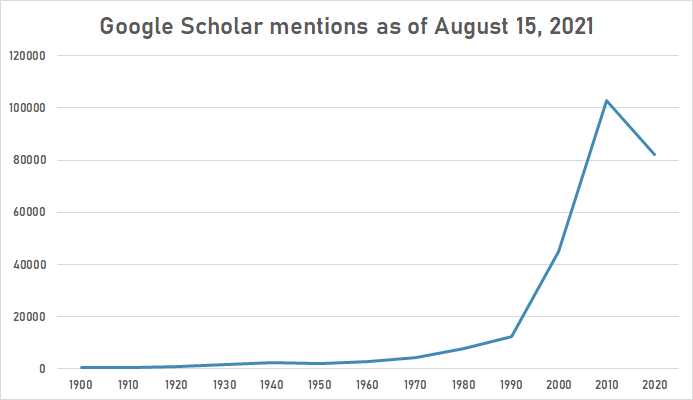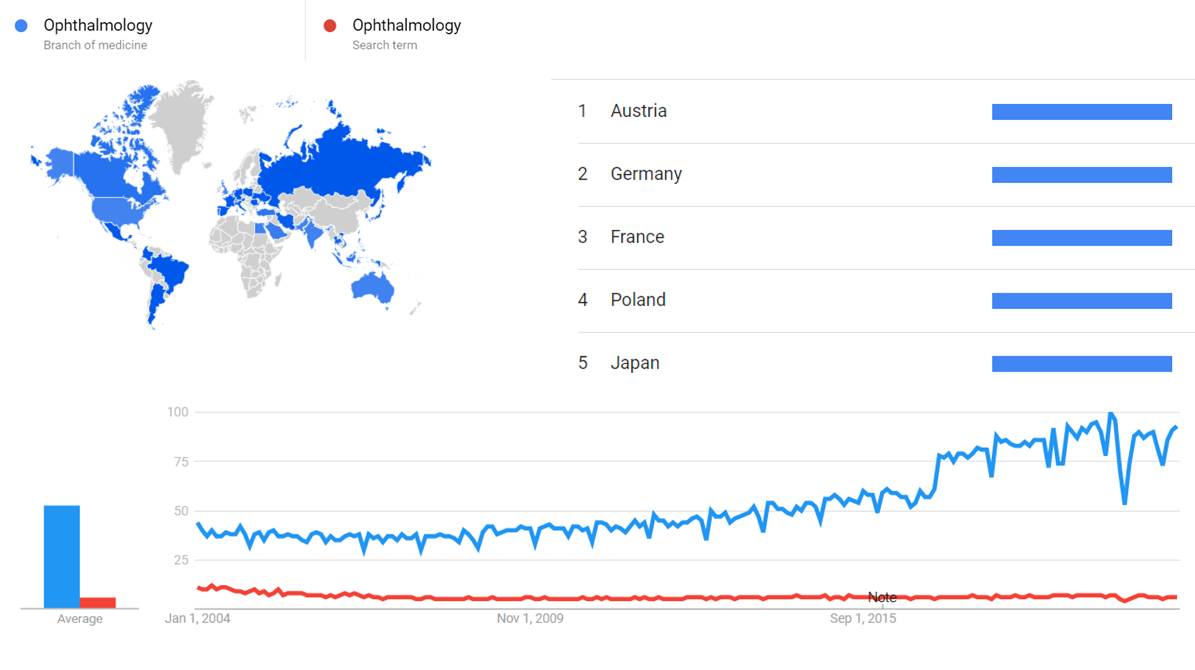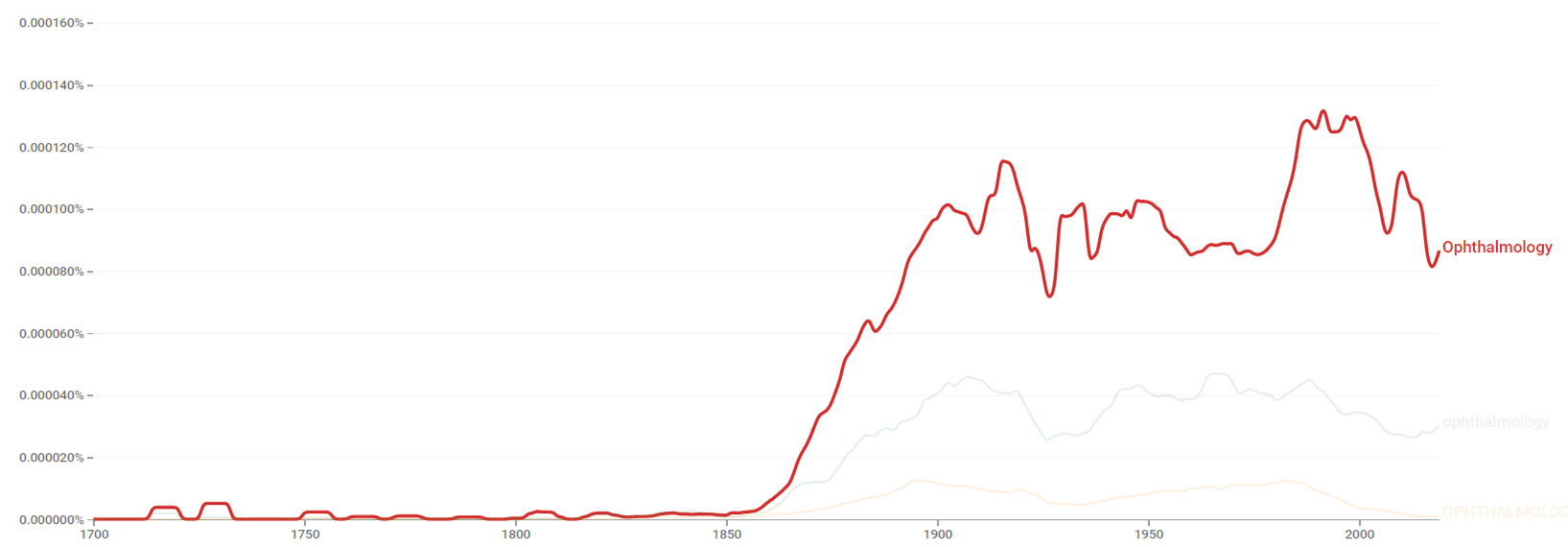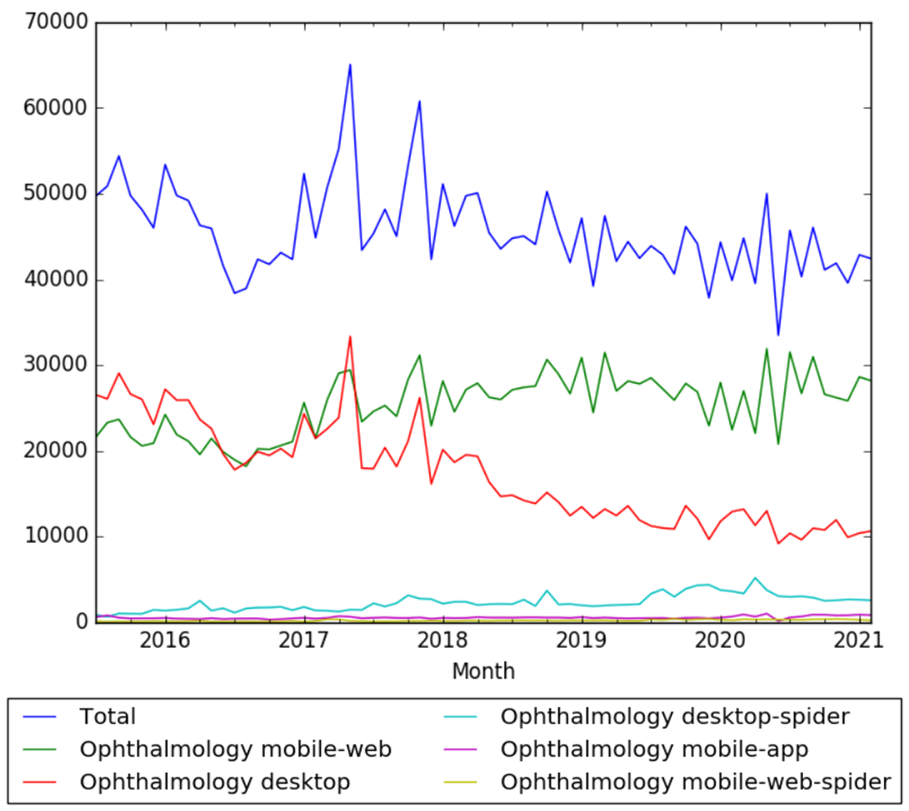Timeline of ophthalmology
This is a timeline of ophthalmology, listing important events in the development of the field.
Big picture
| Time period | Development summary |
|---|---|
| Ancient history | "In ancient times, the anatomical conceptions of the eye were primarily speculatory. The sclera and cornea were understood to form part of the outer layer of the eye, with the pupil and ocular fluid occupying the middle part. This fluid was thought to flow to the brain via a tube. Aristotle introduced empiricism to these fancied structures by dissecting the eyes of animals, and he thus discovered three layers within the eye."[1] |
| Middle Ages | Ophthalmologic progress slows during the Middle Ages. Roger Bacon, however, makes a notable contribution to ophthalmology with his work, Opus Majus.[2] |
| 19th century | "The introduction of the ophthalmoscope in the 19th century brought about a period of consolidation and deepened knowledge of the eye, and treatment of various ocular diseases. This increased the level of precision that was possible in the diagnosis and treatment of ophthalmologic conditions. In particular, the operative treatment of glaucoma was refined at this time, and has helped greatly to improve patient outcomes."[1] |
| 20th century | "Throughout the 20th century, the investigations in the field of ophthalmology were further expanded. Several subspecialties were introduced to focus on particular areas or diseases of the eye. These include cataract, glaucoma, pediatrics, cornea and oncology subspecializations, among others."[1] |
Full timeline
| Year | Event type | Details | Location |
|---|---|---|---|
| 1550 BC | Field development | In the Ebers Papyrus, a section is devoted to eye diseases.[3] | Egypt |
| 800 BC | Field development | Indian surgeon Sushruta describes 76 ocular diseases, as well as several ophthalmological techniques and instruments. Sushruta is particularly interested in cataract surgery, and is referred to as the first cataract surgeon.[1] | India |
| 600 BC | Field development | Surgeons in ancient India already practice couching.[4] | India |
| 25 BC – 50 AD | Field development | Greek philosopher Celsus draws the lens in the center of the eye.[4] | |
| c.70 AD – c.100 AD | Field development | Greek physician Rufus of Ephesus puts forward the concept of a fourth layer, the epithelial layer that covers the eye. Rufus also notes that the eye has two chambers, one filled with water extending from the cornea to the lens, and one filled with viscous fluid occupying the space between the lens and the retina.[1] | |
| 1011 – 1021 | Literature | Arab polymath Ibn al-Haytham writes his Book of Optics.[5] | |
| 1015 | Field development | Arab Muslim ophthalmologist Ammar Al-Mawsili describes the suction of a cataract through the needle.[4] | Middle East |
| 1600 | Field development | Italian anatomist Hieronymus Fabricius illustrates the lens in its true anatomic position.[4] | Italy |
| 1696 – 1762 | Field development | French ophthalmologist Jacques Daviel publishes the first account of cataract extraction through an inferior corneal incision.[4] | France |
| 1753 | Field development | English surgeon Samuel Sharp successfully performs intracapsular cataract extraction.[4][6][7][8] | United Kingdom |
| 1805 | Organization (hospital) | The first hospital dedicated to the practice of ophthalmics opens in London.[1] | United Kingdom |
| 1828 – 1870 | Field development | Prussian ophthalmologist Albrecht von Graefe improves Jacques Daviel's extracapsular cataract extraction technique using a superior corneal incision.[4] | Germany |
| 1846 | Literature | Danish pathologist Adolph Hanover publishes On the Anatomy, Physiology and Pathology of the Eye.[9] | Denmark |
| 1847 | Field development | English mathematician Charles Babbage invents the ophthalmoscope, which enables viewing of the interior of the eye.[10] | United Kingdom |
| 1851 | Field development | German physician Hermann von Helmholtz independently reinvents the ophthalmoscope.[11][12][1][10] | Germany |
| 1862 | Field development | Dutch ophthalmologist Hermann Snellen develops his eponymous Snellen chart to measure visual acuity. The chart would rapidly become a global standard.[13] | Netherlands |
| 1869 | Literature | Archives of Ophthalmology and Otology is released.[14] | United States |
| 1873 | Field development | German physicist Ernst Abbe discovers the optical formula now called the Abbe sine condition, one of the requirements that a lens must satisfy if it is to form a sharp image, free from the blurring or distortion caused by coma and spherical aberration.[15] | Germany |
| 1881 | Literature | Journal Transactions of the Ophthalmological Societies of the United Kingdom is established.[16] | United Kingdom |
| 1884 | Journal | The American Journal of Ophthalmology is established.[17] | United States |
| 1904 | Literature | Journal Transactions of the Ophthalmological Division of the American Academy of Ophthalmology and Oto-Laryngology is established.[18] | United States |
| 1911 | Field development | Swedish ophthalmologist Allvar Gullstrand receives the Nobel Prize in Physiology or Medicine "for his work on the dioptrics of the eye."[19] | Sweden |
| 1917 | Literature | The British Journal of Ophthalmology is established.[20] | United Kingdom |
| 1917 | Field development | Spanish ophthalmologist Ignacio Barraquer invents the first motorized vacuum instrument (erisophake) for intracapsular cataract extraction.[13] | Spain |
| 1922 | Organization | The American Academy of Optometry is founded.[21] | United States |
| 1923 | Literature | Peer-reviewed medical journal Acta Ophthalmologica is established.[22] | Denmark |
| 1924 | Literature | The American Journal of Optometry is established.[23] | United States |
| 1929 | Literature | Journal Archives of Ophthalmology is established by the American Medical Association.[18] | United States |
| 1930 | Field development | Japanese ophthalmologist Tsutomu Sato invents radial keratotomy treatment for myopia.[13] | Japan |
| 1950 | Field development | English ophthalmologist Sir Harold Ridley becomes the first to create and implant intraocular lenses in a two-step procedure.[2] Ridley first implants a polymethylmethacrylate (PMMA) intraocular lens (IOL) following removal of a cataractous crystalline lens.[24][25][26] | United Kingdom |
| 1951 | Field development | Strampelli starts to use anterior chamber intraocular lenses.[4] | Italy |
| 1953 | Literature | The Indian Journal of Ophthalmology is first issued.[27] | India |
| 1958 | Field development | Dutch ophthalmologist Cornelius Binkhorst introduces the first iris-clip lens.[13] | |
| 1960s | Field development | Spanish ophthalmologist José Barraquer, considered the "father of modern refractive surgery", develops lamellar techniques including keratomileusis and keratophakia, as well as the first microkeratome and corneal microlathe.[13] | |
| 1961 | Field development | Polish ophthalmologist Tadeusz Krwawicz develops the first cryoprobe for intracapsular cataract extraction.[4] | Poland |
| 1962 | Journal | Investigative Ophthalmology & Visual Science is launched.[18] | United States |
| 1967 | Field development | American ophthalmologist Charles Kelman develops phacoemulsification, a cataract surgery in which the eye's internal lens is emulsified with an ultrasonic handpiece and aspirated from the eye.[4] | United States |
| 1970 – 1975 | Field development | Charles Kelman pioneers phacoemulsification.[28] | |
| 1975 | Field development | American ophthalmologist Charles Kelman begins designing lens implants to use in cataract surgery.[2] | United States |
| 1980 | Literature | Peer-reviewed medical journal Neuro-Ophthalmology is launched.[29] | |
| 1981 | Literature | Medical journal Current Eye Research is established.[30] | |
| 1984 | Field development | Thomas Mazzocco develops the first foldable intraocular lens.[4][31][28] | |
| 1985 | Literature | The Journal of Refractive Surgery is launched.[32] | |
| 1985 | Field development | Seiler performs the first large area ablation in a human eye to remove a corneal scar having previously performed T-incisions with an excimer laser to correct for astigmatism.[33] | |
| 1986 | Literature | Peer-reviewed medical journal Seminars in Ophthalmology is established. | |
| 1988 | Field development | McDonald performs the first photorefractive keratectomy (PRK) on a sighed eye due for enucleation.[33] | |
| 1990 | Literature | Peer-reviewed medical journal Journal of Behavioral Optometry is launched.[34] | |
| 1992 | Field development | The first commercial optical coherence tomography (OCT) company, Advanced Ophthalmic Devices (AOD), is developed by Fujimoto, Puliafito and Swanson.[28] | |
| 1993 | Field development | The first in-vivo retinal use of optical coherence tomography (OCT) takes place at the New England Medical Center, Tufts University School of Medicine.[28] | United States |
| 1993 | Literature | The Middle East Journal of Ophthalmology is established.[35] | |
| 1995 | Literature | Peer-reviewed open access medical journal Molecular Vision is launched.[36] | |
| 1997 | Field development | The United States Food and Drug Administration approves the first multifocal intraocular lens.[4] | United States |
| 1997 | Organization | The European Association for Vision and Eye Research is formed with the aim of bringing together all European associations involved in ophthalmology and vision science research.[37][38] | |
| 1998 | Field development | The United States Food and Drug Administration approves the first toric intraocular lens.[4] | United States |
| 2007 | Literature | Journal Clinical Ophthalmology is established.[39] | |
| 2009 | Field development | The United States Food and Drug Administration approves the first femtosecond laser system for cataract procedures.[4] | United States |
Numerical and visual data
Google Scholar
The following table summarizes per-year mentions on Google Scholar as of August 15, 2021.
| Year | ophthalmology |
|---|---|
| 1900 | 321 |
| 1910 | 507 |
| 1920 | 805 |
| 1930 | 1,800 |
| 1940 | 2,300 |
| 1950 | 2,210 |
| 1960 | 2,900 |
| 1970 | 4,420 |
| 1980 | 7,690 |
| 1990 | 12,300 |
| 2000 | 45,000 |
| 2010 | 103,000 |
| 2020 | 82,000 |

Google Trends
The comparative chart below shows Google Trends data for Ophthalmology (Branch of medicine) and Ophthalmology (Search term), from January 2004 to March 2021, when the screenshot was taken. Interest is also ranked by country and displayed on world map.[40]

Google Ngram Viewer
The chart below shows Google Ngram Viewer data for Ophthalmology, from 1700 to 2019.[41]

Wikipedia Views
The chart below shows pageviews of the English Wikipedia article Ophthalmology, on desktop, mobile-web, desktop-spider, mobile-web-spider and mobile app, from July 2015 to February 2021.[42]

Meta information on the timeline
How the timeline was built
The initial version of the timeline was written by User:Sebastian.
Funding information for this timeline is available.
Feedback and comments
Feedback for the timeline can be provided at the following places:
- FIXME
What the timeline is still missing
Timeline update strategy
See also
External links
References
- ↑ 1.0 1.1 1.2 1.3 1.4 1.5 1.6 "History of Ophthalmology". news-medical.net. Retrieved 10 September 2018.
- ↑ 2.0 2.1 2.2 "3 HISTORICAL ADVANCEMENTS IN OPHTHALMOLOGY". research.sklarcorp.com. Retrieved 10 September 2018.
- ↑ "History of Ophthalmology". www.mrcophth.com.
- ↑ 4.00 4.01 4.02 4.03 4.04 4.05 4.06 4.07 4.08 4.09 4.10 4.11 4.12 4.13 Preedy, Victor R. Handbook of Nutrition, Diet and the Eye.
- ↑ DK. Timelines of Science.
- ↑ Shaikh, Saad. Eyes on Ice & No Blind Mice: Visions of Science from the Science of Vision.
- ↑ Randleman, Bradley; Ahmed, Iqbal Ike K. Intraocular Lens Surgery.
- ↑ Handbook of Nutrition, Diet and the Eye (Victor R. Preedy ed.).
- ↑ Sebastian, Anton. A Dictionary of the History of Medicine.
- ↑ 10.0 10.1 Hopp, Wallace J.; Lovejoy, William S. Hospital Operations: Principles of High Efficiency Health Care.
- ↑ Tandon, Prakash Narain; Ramamurthi, Ravi. Textbook of Neurosurgery, Third Edition, Three Volume Set.
- ↑ Optics in Our Time (Mohammad D. Al-Amri, Mohamed El-Gomati, M. Suhail Zubairy ed.).
- ↑ 13.0 13.1 13.2 13.3 13.4 Goes, Frank Joseph. The Eye in History.
- ↑ "A New Editor and a Birthday for the Archives of Ophthalmology". jamanetwork.com. Retrieved 13 September 2018.
- ↑ "Ernst Abbe". britannica.com. Retrieved 10 September 2018.
- ↑ Lotery, A J; Watson, P. "EYE: a journal to be proud of". doi:10.1038/eye.2013.49. PMC 3650288.
{{cite journal}}: Cite journal requires|journal=(help) - ↑ "American Journal of Ophthalmology 1993–2002: A Decade of Change". ajo.com. Retrieved 13 September 2018.
- ↑ 18.0 18.1 18.2 Cole, Jim; Stankus, Tony. Journals of the Century.
- ↑ "The Nobel Prize in Physiology or Medicine 1911". nobelprize.org. Retrieved 18 September 2018.
- ↑ "British Journal of Ophthalmology" (PDF). bjo.bmj.com. Retrieved 13 September 2018.
- ↑ "What is the Academy?". aaopt.org. Retrieved 30 September 2018.
- ↑ Heijl, Anders. "Acta, Past and Future". onlinelibrary.wiley.com. Retrieved 13 September 2018.
- ↑ "Early and Miscellaneous Periodicals Collection" (PDF). aoa.org. Retrieved 30 September 2018.
- ↑ Sitharaman, Balaji. Nanobiomaterials Handbook.
- ↑ The Sight-saving Review, Volumes 30-31 (National Society for the Prevention of Blindness, Incorporated, 1960 - Eye ed.).
- ↑ Garg, Ashok; Chang, David F. Advances in Ophthalmology.
- ↑ "IJO". ijo.in. Retrieved 18 September 2018.
- ↑ 28.0 28.1 28.2 28.3 Boyd, Benjamin. Modern Ophthalmology: The Highlights.
- ↑ "Reviews in Neurology and Ophthalmology". healio.com. Retrieved 18 September 2018.
- ↑ "Current Eye Research". tandfonline.com. Retrieved 18 September 2018.
- ↑ "Phaco turns 50". eyeworld.org. Retrieved 27 September 2018.
- ↑ "Development and Growth of the ISRK". Retrieved 18 September 2018.
- ↑ 33.0 33.1 Nema, HV; Nema, Nitin. Recent Advances in Ophthalmology-12, Volume 12.
- ↑ "Our Human Family" (PDF). ovpjournal.org. Retrieved 18 September 2018.
- ↑ "Middle East African Journal of Ophthalmology". meajo.org. Retrieved 13 September 2018.
- ↑ "Web journal receives national recognition". emory.edu. Retrieved 18 September 2018.
- ↑ "Dr Barraquer, a member of the University Advisory Council, has been appointed president of the European Association for Vision and Eye Research". uic.es. Retrieved 18 September 2018.
- ↑ "European Association for Vision and Eye Research". ever.be. Retrieved 18 September 2018.
- ↑ Fraser, Scott G. "Welcome to Clinical Ophthalmology". PMC 2699991. PMID 19668460.
{{cite journal}}: Cite journal requires|journal=(help) - ↑ "Ophthalmology". Google Trends. Retrieved 25 March 2021.
- ↑ "Ophthalmology". books.google.com. Retrieved 25 March 2021.
- ↑ "Ophthalmology". wikipediaviews.org. Retrieved 25 March 2021.